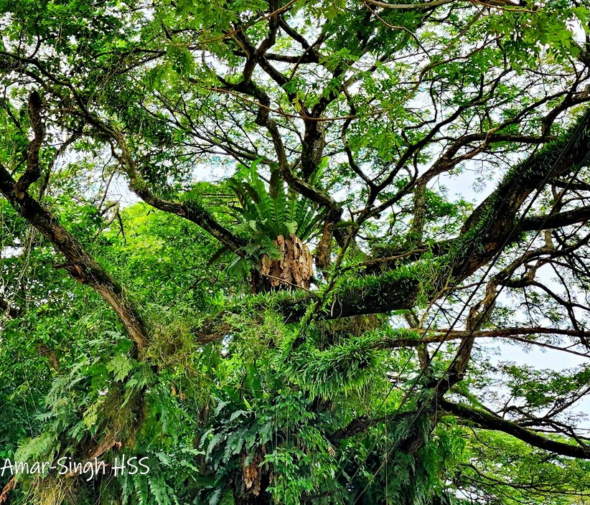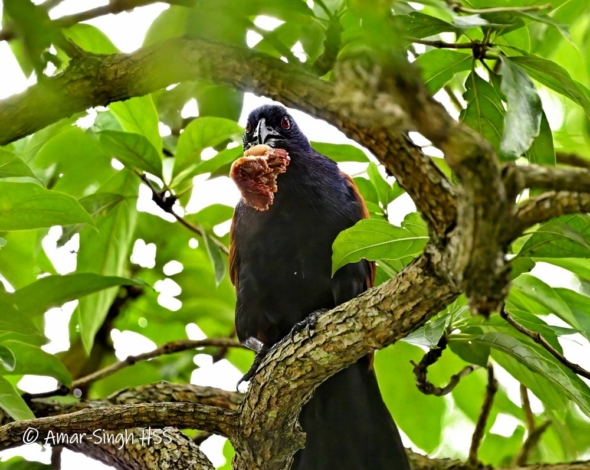I have observed Greater Coucals (Centropus sinensis) nesting in the past and nests have been in tall grasses and thick bushes fairly low down. I was at the outskirts of Ipoh City on 7th November 2022, when I observed a pair nesting high in a tree.
I have often seen a pair in this Samanea saman tree (Rain Tree) when I visit the location. On this occasion I was alerted to their presence by a call duet between the pair; possibly part of the breeding activity. I spotted one bird with a twig in the mouth (Image 1), suggesting nest building.

I observed the pair as they moved up the tree. One of them entered within an Asplenium nidus (Bird’s-nest Fern), located 6-7 meters up in the crown of the tree. There is no access to see within the fern (Image 2) but my observations suggest that the nest is located within the Asplenium nidus.

I subsequently saw one of the pair bring food, possibly meat/roadkill, to the nesting location (Image 3). This suggests that the first bird was enhancing the nest, as is often seen in many birds, and there are juveniles in the nest.

Greater Coucal nests are usually close to the ground. Wells (1999) describes nests as “A large globe with a lateral entrance, built grass or palm leaflets, one externally disguised wit fronds of ferns that were growing around it. Site include fern tangles and pandan crowns, up to 2.5 above ground.” A number of websites suggest nests in trees at higher elevations. Thai National Parks (2022) states “The nest is a deep cup with a dome in dense vegetation inside tangles of creepers, bamboo clump or Pandanus crowns. They can be built as high as 6m above the ground ….”
Natarajan (1997), who studied the breeding biology, offers data on 45 nests observed. “28 (62,2%) were found on thorny plants and the rest on thornless plants, where the canopy was covered with climbers such as Tinospora cordifolia , Rivea hypocrateriformis, and Mucuna pruriens”. “Out of 38 nests studied in the villages, nests were most frequently located in Prosopis chilensis (23.7%), followed by Bamboo sp. (18.4%). Seven nests were located in the forest, three of which were on Zizyphus oenoplia. Among the 45 nests studied, 75,6% were placed in the periphery of the nesting tree and 24.4% were located in the centre of the canopy. In the villages the maximum number of nests were located between 4-5 m (34.2%) height, but in the forest 71.4% of the nests were located at heights between 3-4 m. In the village two nests were noticed on Borassus flabellifer (covered with Rivea hypocrateriformis) at a height of 9.6 m and one nest on Tamar Indus indica at 10.7 m.”
Hence, it does appear that some Greater Coucals may nest high up in a tree, as I observed.
Asplenium nidus (Bird’s-nest Fern) are known to bird watchers as ferns used by some bird species to nest or as roosts; including the Barred Eagle Owl (Ketupa sumatranus), Spotted Wood-Owl (Strix seloputo), Buffy Fish-Owl (Ketupa ketupu), Verditer Flycatcher’s (Eumyias thalassinus) (Wee 2011).
References:
- Natarajan, V. (1997). Breeding Biology of the Southern Crow-Pheasant Centropus sinensis parrotiStresemann (Aves: Cuculidae) at Point Calimere, Tamil, Nadu. Journal of the Bombay Natural History Society, 94(1): 56-64. (Available here: https://www.biodiversitylibrary.org/part/156247)
- Thai National Parks (2022). Species of Thailand Birds: Greater coucal <https://www.thainationalparks.com/species/greater-coucal>
- Wee YC (2011). Birds using ferns as nesting sites. Bird Ecology Study Group. <https://besgroup.org/2011/11/19/birds-using-ferns-as-nesting-sites/>
- Wells, D.R. (1999). The birds of the Thai-Malay Peninsula: Vol. 1 (Non-passerines). Christopher Helm, London
Dato’ Dr Amar-Singh HSS
Ipoh, Perak, Malaysia
Note to readers: If you like this post please tap on the Like button at the left bottom of page.








